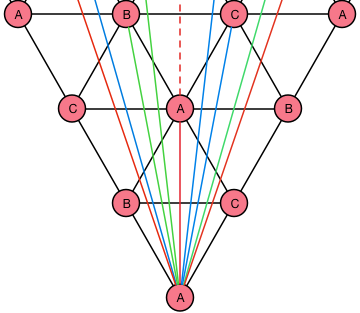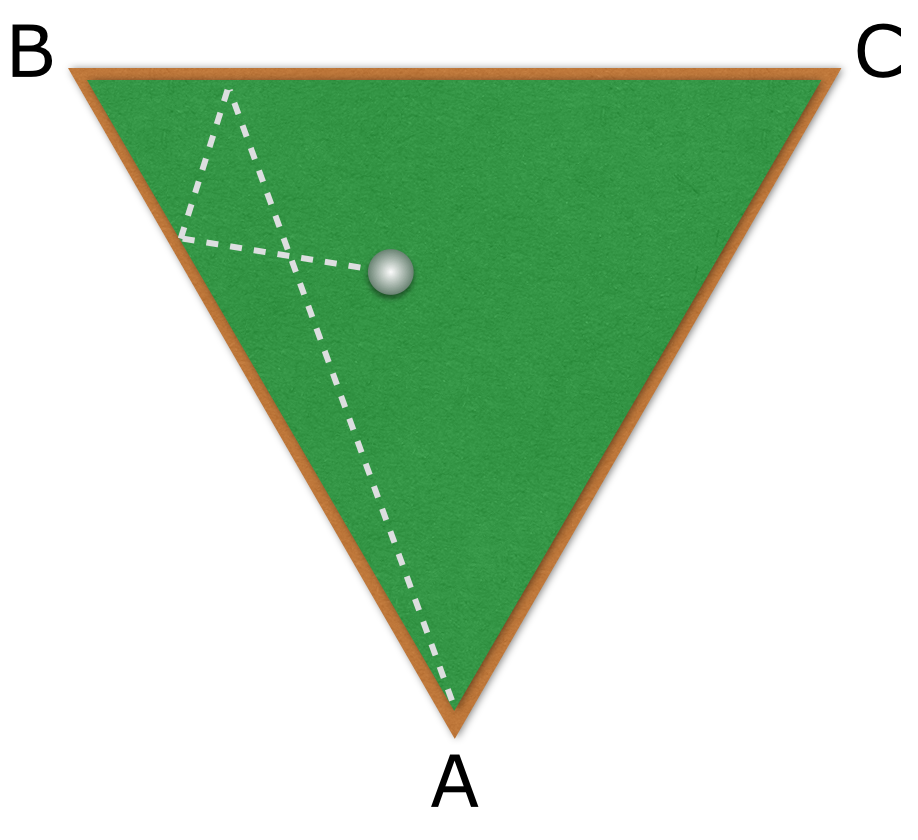Figured I might as well post my full resolution here. I will use a lot of @user3294068's reasoning here, so feel free to read on the initial part of his answer, with the mirror and virtual image thingies.

Suppose the initial triangle has side length $1$. We will use a Cartesian coordinate system in which the initial vertex $A$ is the origin. We will say the level $l$ triangle is the equilateral triangle with side length $l$ that contains the initial vertex $A$, so for instance the big triangle in the image below is the level $3$ triangle:

First, an important observation: a corner is hit in the top side of a level $l\geq 2$ triangle if and only if the ball crosses $2l-3$ black lines; in other words, if and only if it bounces $2l-3$ times. Thus, for the ball to reach a corner after bouncing $20160127$ times, the corner must lie on the top side of the level $n=10080065$ triangle. We will hereafter omit ‘the top side of’ for brevity and readability.
Now, because $n$ is odd, any corner on the level $n$ triangle will have $x$-coordinate in $\mathbb{Z}+\frac12$. Hence, any such corner that is hit belongs to the line $\gamma$ given by $y=a \cdot x$, where$$a = \frac{n\sqrt{3}}{2}\cdot\frac{1}{p+\frac12}$$for some $p \in \mathbb{Z}$ satisfying $p + \frac12 \leq \frac{n}{2}$.
We will make an analysis for the corners with positive $x$-coordinate without loss of generality; at the end, it suffices to double the result obtained. Notice that $x=0$ is always obscured except for the level $2$ triangle.
For a corner to be hit, it must not be obscured by some corner lying on a lower level triangle. If it is obscured, then there must be some integer $m < n$ and $q \leq \frac{m}{2}$ with $(q,m) \in \gamma$. Here, $q \in \mathbb{Z}$ if $m$ is even, and $q \in \mathbb{Z}+\frac12$ if $m$ is odd. Thus, if a corner is obscured the following equality must hold:
$$m\cdot\left (p+\frac12\right)=n\cdot q \iff m(2p+1) = n\cdot 2q\tag{1}$$
Notice that regardless of the situation, $2q \in \Bbb Z$.
Claim: Let $K$ be a corner on a level $n$ triangle, where $n>2$ is odd. Let $p+\frac12\in \Bbb Z +\frac12$ be $K$’s $x$-coordinate. Then $K$ is obscured if and only if $2p+1$ contains a factor of $n$.
Proof:
Consider equality $(1)$ in terms of prime decomposition: if $2p+1$ did not contain any of $n$'s prime factors, then they would all show up on $m$'s prime factors, which would contradict $m<n$.
It follows that whenever the equality holds, $2p+1$, contains a factor of $n$.
Now, suppose $2p+1 = c\cdot f$, where $f\geqslant 3$ divides $n$.
Observe that $2p+1$ and $n$ are odd, so the assumption $f\geqslant 3$ is justified.
We consider cases.
If $m$ is even, then $q\in \Bbb Z$ and we pick $m = \frac {2n}f$ and $q = c$.
Because $f\geqslant 3$, it holds that $m< n$.
With this in mind, we have
$$q \leqslant m/2 \iff c \leqslant n/f\iff 2p+1 = cf \leqslant n,$$
which is true by hypothesis.
If $m$ is odd, then $q\in \Bbb Z+\frac12$ and we pick $m = \frac nf$ and $2q = c$.
Once again, $f\geqslant 3$, so $m< n$.
Finally,
$$q \leqslant m/2 \iff 2q \leqslant m \iff c \leqslant n/f \iff 2p+1 = cf \leqslant n,$$
which once again is true by hypothesis and concludes the proof. $\square$
Using the claim it is easy to solve the problem.
Of course, we are only interested in corners of type $A$;
these corners have $x$-coordinates of the form $x =\frac12 + 1 + 3j$, $j \in \mathbb{Z}$.
Remember it must be $x \leq \frac{n}{2}$, or $2x \leq n$. We are thus interested in finding all numbers of the form $6j+3$ that are $\leq n$ and that are coprime to $n$.
A computer search can solve this in no time, and finds $1264940$ solutions, so that the total is twice that much, or $2529880$.
Using modular arithmethic and inclusion-exclusion, it’s actually not too hard to do it by hand;
I’ve done it and got the same result.



